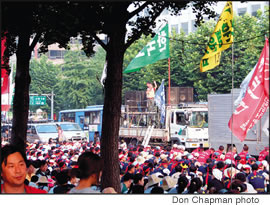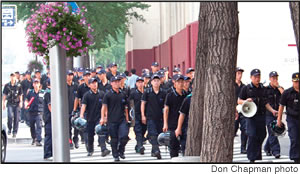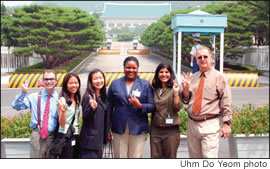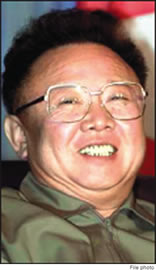As Different As Neighbors Can Be
This is the third of a three-part series based on an East-West Center fellowship and being part of the first Korea-U.S. Journalists’ Exchange Program.

Sign of a vibrant democracy:
Striking hospital workers demonstrate
in downtown Seoul
Walking out of the Koreana Hotel on my first day in Seoul, I ran smack into a phalanx of about 200 black-clad riot troops with helmets, shields and big sticks marching down the sidewalk. So I did the only sensible thing and followed them. Which soon put me between about a thousand riot cops and 400 angry demonstrators. I wasn’t sure what they were shouting about — it could have been an anti-U.S. rally for all I knew — but the next morning read in Seoul’s two English-language papers that they were striking hospital workers. Days later they got their deal. “Almost every day there’s a street demonstration in Seoul,” says an official at the U.S. embassy. “It’s how they earned their democracy here. In the 1960s, ’70s and early ’80s, the government cracked down on demonstrators, people were killed or imprisoned and tortured.” During the Gwangju Massacre in May 1980 when students took to the streets to protest the declaration of marshal law by a former general who took over in a coup, 207 people were killed by government forces and nearly 1,000 injured. Students of that generation are called “368s” — in their 30s now, born in the ’60s, students in the ’80s — and are rising to power in government, business and media.
Adds another U.S. official: “Democracy is here big-time now. It’s what we wanted. And democracy is a messy business. It’s very difficult to exaggerate the extent to which South Korea is in a state of flux, especially in their political roles … Very few (demonstrations) have anything to do with the U.S., and if they do they’re typically not a big deal — it’s easy for CNN to fill the screen with 45 people.”
Although the majority of demonstrations only involve lots of shouting, chanting and singing, you see riot cops, young conscripts in black polo shirts, all around Seoul, but especially outside the U.S. embassy and our Army’s Yongsan base. (Yongsan, the huge, historic base that has seen metro Seoul expand and grow around it, is in the process of being closed and the garrison moved from that now very expensive chunk of real estate to south of the city.)
Unsettling as riot cops hanging out on street corners may be at first, they soon become part of the landscape. And the lively democracy — remember the brawl in the National Assembly a couple of years ago? — that requests their presence to keep things civil is far better than conditions north of the DMZ, where only one view is permitted, that of the “Dear Leader” Kim Jung-Il. Across the border from probably the most vibrant democracy in the world today is probably its foulest state, where people have been brainwashed for 60 years, and arrest, torture and murder follow even a hint of protest or questioning thought. And where 2 million to 3 million people have starved to death in recent years while the leadership drive Mercedes, drink Remy Martin and build nukes.

Young riot police march past
the Koreana Hotel on their way to
confront striking hospital workers
IF NORTH and South Korea were united, they would comprise earth’s most homogenous nation. They speak the same language and share the same family names — if you’re not a Kim, Park or Lee, you’re in the minority. Eight million people in the South have family across the DMZ. Yet no two neighbors are more different than North and South Korea. Perhaps you’ve seen the photo on the Internet of the two countries at night. The South is lit up like a Christmas tree, but with the exception of the capital Pyeongyang, the North lives in the dark (www.globalsecurity.org/military/world/dprk/dprk-dark.htm). South Koreans take pride in being the world’s most “wired” nation, with seemingly every resident of Seoul owning a cell phone that also functions as camera, e-mailer,music player and game console. Text-messaging is rampant. This is the land of Samsung.
Across the border, meanwhile, Kim Jung-Il recently cut about 80 international phone lines, leaving his government (and, thus, the rest of the country) just nine. Less than a year and a half after issuing cell phones, the government recently rounded them up again. Internet is not allowed. The fear, apparently, is as much about information from the North getting out as it is news from the outside world coming in. So South Korean workers who travel daily to Gaeson in the North to build factories in a new “economic zone” are searched for newspapers and cell phones. His paranoia is so great, Kim also recently cut the government’s intranet, preventing agencies from communicating. Korea was historically called the Hermit Kingdom, and the North today is carrying on as the Hermit Dictatorship.
While reunification is the greatest goal in South Korea, people in the South also fear a sudden collapse of the Kim regime. Germany is the model cited, a worthy analogy — except that North Korea is way more backward than communist East Germany was. The cost of eventual reconstruction will be enormous and require years of international support. To avoid forcing the 11th largest economy in the world to suddenly absorb one of the least productive — and one where the people have been taught for decades that the people in the South are devils in cahoots with the evil Americans, and both are intent on attacking and killing everyone in the North — the South’s reunification plan calls for gradual steps, such as the Gaeson economic zone and Gungan Mountain Resort in North Korea.
(While Seoul hopes for longterm improvements in the North, an official at the U.S. embassy said our position is just the opposite: “We’d like an immediate regime change.” Thus another sticking point in U.S.-South Korea relations. But for now, the Bush Administration seems to be giving South Korean diplomacy, and some of our own, a chance.) The South’s phoenix-like rise from the ashes of the Korean War, which left only a couple of buildings standing in Seoul, has rightly been called a miracle. After suffering their own food shortages in post-war years when Korean grandmothers went without meat so children would be better nourished, South Korea is today a veritable breadbasket. Or rice bowl. From the DMZ in the north to Busan in the south, every available inch of tillable soil seems to be used for farming — endless rice paddies mixed with corn, tomato, watermelon and sesame fields, grape, pear and apple orchards, and more. South Korea also ranks No. 4 in U.S. agricultural exports. Life here is good, comfortable, well nourished. Yet across the border, North Koreans continue to starve — the forecast is that this summer’s riceharvest will again come up short of the nation’s need. In large part, this is the result of long-term awful management by the communist government, mixing poor agriculture practices and land management (including widespread deforestation, leading to floods that destroy crops and farmland) with spending millions of dollars on arms. But there’s more to it than just another large-scale failure of communism.
“I don’t think it was a famine alone that killed all those people,” says a U.S. Army officer at Panmunjeom who has spent the past dozen years studying the North’s leadership, “but selected starvation of certain groups. Farmers who agitate for reforms and better conditions have their food taken away and given to someone else more loyal … Kim Jung-Il has created a culture of dependence, on him.” The result of long-term food shortages, says a U.S. embassy official in Seoul, is a people who are “physically and perhaps mentally stunted. It’s a fact that South Koreans are significantly taller and heavier than North Koreans.” Which was obvious at the DMZ, where South soldiers were far bigger and more imposing than those we faced on the North side.
Between starvation, torture and murder, the Army officer adds, Kim Jung-Il “has killed more of his own people than Hitler did.” President Bush OK’d food shipments to North Korea (through the World Food Agency) independent of nuclear talks — “The president is a softie on food issues,” the officer says — and the South sends tons of rice and fertilizer north. Perhaps not too surprisingly, it’s known that some of that same rice, soon after crossing the border, finds its way to North Korean soldiers along the DMZ.
Those loyal to the regime live quite well. “Visit Pyeongyang and you’ll be amazed at the number of Mercedes on the streets,” the officer says.
Adds another official at the U.S. embassy: “One of Kim Jung-Il’s strengths is that his people can’t see the success of the South.”
The North Korean soccer team must surely be in that group of well-nourished loyalists. Their bus was pulling up to the Hotel Spapia in Daejeon (to play in a tournament at the city’s World Cup stadium) just as our bus was leaving, and players from the North were all eyes looking out at the modern, gleaming “Science City” of 1.2 million. If it were China, Japan or Thailand, perhaps they could easier reconcile the obvious bustling success there. It must be tougher to take knowing such prosperity and luxury, not to mention freedom, is being enjoyed by cousins a few miles across the border. It doesn’t take a terribly deep thinker to realize which system best provides for its people.
THE BEST way to understand North Korea, said a Korea expert on the staff of the Commander- U.S. Pacific Command at Camp Smith who briefed me before I left for Korea, is as a “mafia regime.” When I mentioned this to the Army officer at Panmunjeom, he added that it’s a “mafia state that follows an Amway model.” Meaning the guy at the top gets a cut of everything. With no manufacturing and no exports, and with under-producing agriculture and fisheries programs caused by bad management and failure to invest in modern equipment, North Korea is known to traffic in weapons, drugs and humans to generate cash.

The six Americans chosen for
the first Korea-U.S. Journalists’ Exchange
Program in front of Korea’sofficial
presidential residence, the Blue House,
so named for the roof. From left,
John Walker of the Fox
affiliate in Washington, Vanessa Hua
of the San Francisco Chronicle, Courtnay
Peifer of Newsday in New York,
Michelle Burford of Oprah Magazine in
New York, Reena Advani of National
Public Radio in Washington and yours
truly, MidWeek’s editor. It was an honor
and a pleasure to spend nearly two
weeks traveling with these great
journalists who are also terrific people
“They’re also very good at counterfeiting various currencies,” the Camp Smith officer added. “And because of the nature of some of the nations with which they do business — Syria, Iran, Pakistan — they’re very good at counter-counterfeiting. They don’t trust anybody.”
It is precisely because of the nature of the regimes with which Kim Jung-Il is chummy that U.S. military officers fear that — more than a nuclear attack on Seoul, Tokyo, Honolulu or U.S. West Coast cities — the greatest danger posed by North Korean nukes is that they could end up in the hands of a terrorist and be used in an American city, or against another “Western” target. “South Koreans are not at all concerned about North Korean nukes being used against them,” an embassy official told us. “That goes a long way in explaining their Sunshine Policy toward the North. But we see North Korea nukes as a real threat to the U.S.” Students at Namchong National University in Daejeon with whom we spoke echoed that sentiment. They simply cannot bring themselves to believe the North would ever again attack the South. So the big question for the U.S. — and for Hawaii, which Kim Jung-Il says he can reach with his newest nuke-carrying missiles — remains:Will North Korea ever give up its nuclear weapons and capacity, or stop adding to its arsenal?

Kim Jung-II, ‘Dear Leader’
In my studied opinion, no. Here’s why:
North Korea has spent 30 years developing its nuclear program. In the eyes of its leadership, nuclear weapons make North Korea an important nation, one that must be respected and feared by other powers. “A big part of the problem,” said the officer an Panmunjeom, “is they believe their own propaganda.”
The U.S. and European powers said nothing about Pakistan acquiring nuclear weapons, and George Bush, on the eve of the Six-Party Talks last month, welcomed India into the league of nuc-u-ler nations. “The North leadership is following the Pakistan example,” the officer said. “We’d like them to follow the Libya example, give up their nukes and enjoy vastly improved relations with the U.S.”
To give up his nuclear weapons and capacity would cause a humiliating loss of “face,” and Kim has lots of face to save. He is a god-like figure to North Koreans, who for decades have been told of his many miraculous accomplishments, such as in his first round of golf making 11 holes in one.
Also, both political hard-liners and those who personally profit from the North’s illegal dealings might make it impossible to pull back even if Kim were inclined to do so.
Ultimately, without nukes North Korea has no other bargaining chips with which to barter economic and diplomatic concessions from other countries, especially South Korea and the U.S.
So, no, he’s not giving them up willingly.
That said, is there hope for the Korean peninsula, and ultimately northeast Asia?
In my opinion, yes. Here’s why: The South’s Sunshine Policy seems to be creating a sense of trust between the two cousins for the first time, and South Korean diplomats have succeeded in getting the Bush Administration to tone down its rhetoric. (The appointment of Chris Hill, former ambassador to Seoul, as the top U.S. negotiator at the Six-Party Talks is also seen as a smart and constructive move by Bush. Or Condi Rice, as the case may be.) China, as North Korea’s major benefactor (it receives 80 percent of its energy from China), can exert influence over the North (although a member of Korea’s National Assembly with whom I spoke said China is afraid of pushing too hard and “losing North Korea”). As an emerging economic powerhouse, China above all else wants stability in Northeast Asia. And if the North doesn’t give up its nukes, Japan could give up its Peace Constitution and begin a nuclear program, a very destabilizing influence and probably the last thing China wants to see in the region — especially with memories of Japan’s aggression that led to World War II still so strong.
While the North regime could last another 60 years, it could also collapse tomorrow (but that’s not something on which to base policy, as the Bush Administration seems to have done earlier).
Ultimately, the U.S. and South Korea can offer Kim Jung-Il all kinds of carrots to give up his nukes, such as the South’s proposal to provide additional electricity for the North, but without the threat of a stick somewhere in the process — hopefully proffered, if it hasn’t been already, at the Six- Party Talks that are scheduled to restart Aug. 29 — he’ll continue to do what he’s been doing for years. Which is, basically, jerk us around. And as mentioned in last week’s column, with his artillery massed along the DMZ and aimed at Seoul, he has an upper hand.
Bottom-line assessment: First, the U.S. and South Korea should sign a peace accord with the North, 52 years after we signed the armistice.
Second, do all we can to support South Korean diplomacy in the region, and hope it works. Third, assume the North will continue to produce nuclear weapons and will have no shortage of would-be buyers.
Fourth, do everything we can short of causing a Korean War II to aggressively prevent North nukes from entering the hands of those who would use them against the U.S. and other allied targets. Fifth, keep them out of the U.S.
E-mail this story | Print this page | Comments (0) | Archive | RSS Comments (0) |
Most Recent Comment(s):





 Del.icio.us
Del.icio.us








